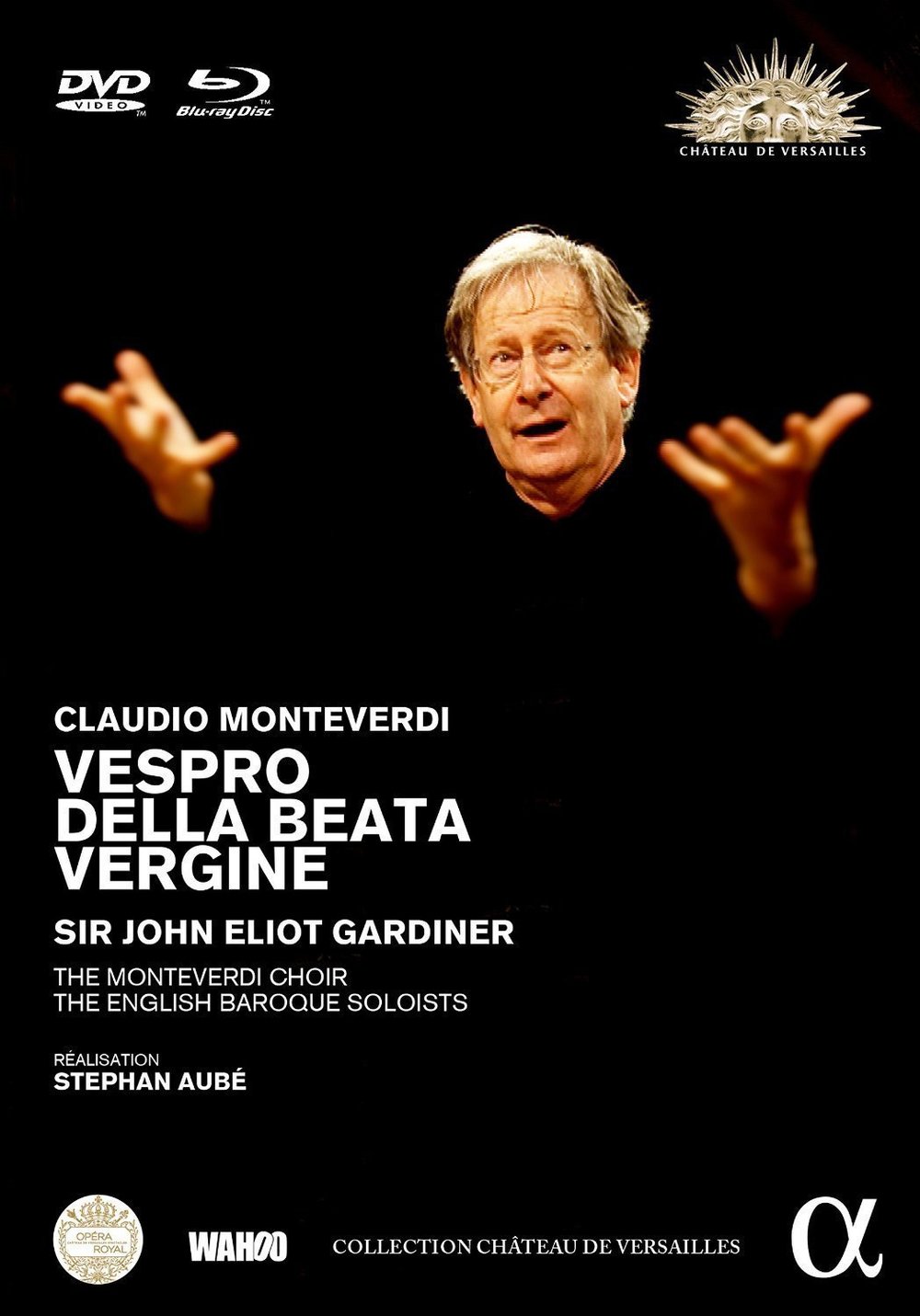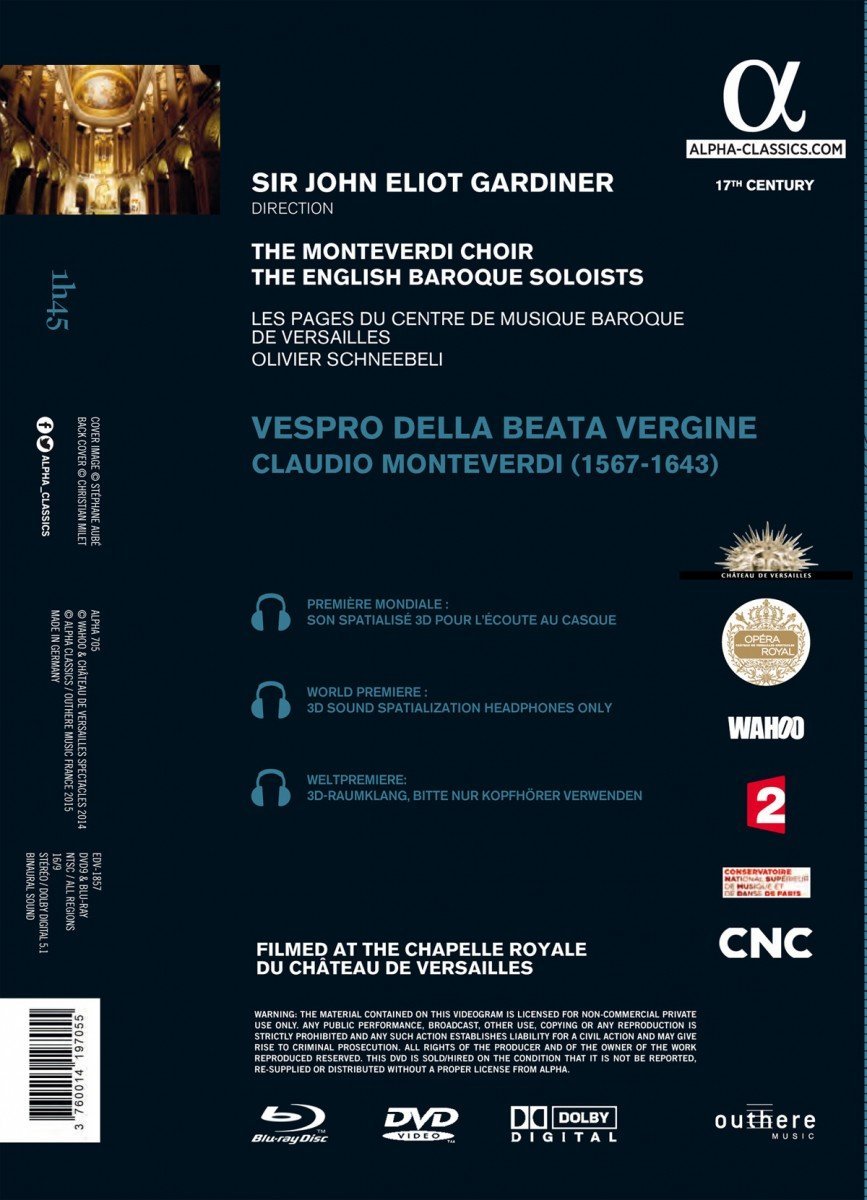

Monteverdi 💓 Vespro della beata vergine (Vespers for the Blessed Virgin). Recorded 2014 at the Versailles Chapelle Royale. Sir John Eliot Gardiner conducts the Monteverdi Choir and The English Baroque Soloists. Olivier Schneebeli conducts the Juvenal Choir of the Versailles Center for Baroque Music. Directed for TV by Stéphan Aubé; produced by Frédérick Allain. Sung in Latin. Released 2015, disc has 5.1 dts-HD Master Audio sound output. Grade: A
This is an astonishingly high-quality recording because it's:
Sir John Eliot Gardiner's last (of 3) recordings of the Monteverdi Vespers
The first HDVD to be recorded completely in the Chapelle Royal at Versailles
Our first chance in HDVD to see the Monteverdi Choir in concert
The first time the English Baroque Soloists Orchestra has recorded in HDVD
Our best opportunity yet to see ancient instruments in HD
The first recording you can enjoy in true "Binaural Sound" (if you can figure it out)
A dual-disc title with a Blu-ray and DVD. Watch both and you'll never watch another DVD
We'll cover all these points in some detail (out of order) as we enjoy some screenshots.
The venue for this concert is the Royal Chapel (Chapelle Royal) at Versailles, seen below in the first picture (a stock photo). It's the church where Marie Antoinette married Louis XVI. I've visited Versailles 3 times, but I've yet to see the Royal Chapel. It's connected to rest of the castle, but I think it's too small to expose to throngs of tourists. You have to take a special guided tour. Now folks like Cecilia Bartoli and Lang Lang can rent the Hall of Mirrors to make a concert recording. But my impression is only sacred music can be performed in the Chapelle Royale:
This is obviously a spectacular place for a concert video. It's also a place creating dramatic sound effects. You can see a balcony above the altar that holds tall organ pipes and runs all around the main floor. For this performance, the orchestra is on the ground floor in front of the altar and the main floor is covered with seats for the audience. From time to time members of the orchestra and the chorus leave the temporary stage to take positions on the balcony and to the sides and to the rear of the audience. Below is a shot with a member of the choir on the balcony opening the work:
Below is the shot above as it appears in the DVD. Can you tell the difference?
Next below is a view with all the singers on stage. It's hard to put into words how beautiful this music is. John Quinn, writing for MusicWeb International, says, "[w]atching and listening to this performance of the Monteverdi Vespers has been a thrilling experience." The best way I can explain it is this: the pictures you see here are from one of the most beautiful music videos ever made, and the musicians sound even better than they look:
Monteverdi published his Vespro della beata vergine in 1610, the same year Shakespeare wrote The Winter's Tale. Vespro soon fell into obscurity and was rarely performed. 350 years later, Sir John Eliot Gardiner, while attending college, founded the Monteverdi Choir and revived Vespro in a famous concert (performed in 1965). Since then Gardiner has been in the vanguard of the early music movement and also served many orchestras as conductor in most genres of music. He has made hundreds of distinguished recordings including highly-regarded versions of the Vespro. Subject title is Gardener's attempt to republish Vespro della beata vergine one last time using state-of-the-art video and sound to outshine all recordings of this work made before:
Below is Jakob Lindberg, one of the world's most distinguished lutists, playing a chitarrone. There are many passages in this recording that demonstrate the astonishing range and sound of this lute-like instrument:
Next below we see Valerie Botwright sawing away on her double bass as the sole member of the rhythm section. Then in the foreground are sackbuts, or early trombones. The sackbut furthest away is a bass version:
Here's a different angle on the bass sackbut. Its slide is longer that a man's arm and is equipped with an extension rod! The modern bass trombone solves this problem by coiling up some of the tubing next to the musician's head:
I normally don't like instrument-only shots in music videos, but here's an exception: a close-up of 3 cornetts. The cornett is made of wood covered with leather. It has holes a bit like a flute. It has a brilliant piercing sound like a trumpet. But otherwise, it's not related to the the modern trumpet. Nor does it have a connection with the modern cornet, which is spelled with a single "t":
The cornett is played with a tiny trumpet-like mouthpiece, and is said to be one of the most difficult instruments to master:
In the old days, the instrument below was called a flute, but we would call it an early recorder:
The Baroque Soloists is a tiny band. Here we see the two violins and one of the two violas. There's also one cello and one viol da gamba:
Now in the next view you can probably spot most of the instruments we noted above. If you look really hard, you can probably make out Jane Gower, sitting behind the recorders, playing a dulciane, which is an early bassoon:
The star soprano is Silvia Frigato. I think she's a fully-qualified opera singer, but she's probably too petite for many opera roles:
The star tenor is Nicholas Mulroy:
Here we see Frigato in a duet with Emanuele Galli. Gardiner lets his singers show all the emotion they can—nothing is stilted as in a church service. Frigato is standing on a box:
Seven musicians leave the stage and proceed to the rear balcony:
So now the audience is surrounded with sound:
Now we see the Juvenile Choir of the Versailles Center for Baroque Music gathered on the balcony in front of the Chapel Organ, the doors of which are closed. All the singers of the Monteverdi Choir are now in place. The four empty chairs are for the recorder and the dulciane players, who are elsewhere. Gardiner brought his own clavecin and organ:
Just so you will know, the Chapel Organ does work. Next below is a picture of it with its doors open. It's being played for Cecilia Bartoli's rendition of a Stabat Mater in her Mission HDVD:
Next below are 2 close-ups of the youth choir. The unidentified soloist, maybe 13, will get special acknowledgement from Gardiner when taking bows at the end:
And here's what happened to the recorders and the dulciane:
Finally, below are more architectural shots—maybe more than you might want to see while concentrating on the music:
Lindsay Kemp, writing in the February 2016 Gramophone at page 75 says, "the shot of [the] decorated ceiling while invisible tenors call to each other in the dizzying 'Duo Seraphim' is as moving and theatrical a moment as anything."
This was an ideal venue for the "world premiere" of "3D Sound Spatialization" technology. Many people are working on this sort of thing in many countries. In nature, you hear fabulously accurate surround sound with only two ears. The brain knows where each sound is coming from because it arrives at each ear at a slightly different time.
So how do you take advantage of this ability of the brain in a home theater? Work on "real" stereo is being done now with uncomfortable earphones and with sophisticated noise cancellation technology designed to deliver only one channel of sound to each ear. If they can figure out how to do this, you might need only two speakers in your home theater. The keepcase booklet is vague about what "3D Sound Spatialization" is, but I think technology is described in a technical paper backed by the Paris Conservatory published in November 2012.
If you access the list of audio tracks from the Main Menu, you get three choices:
DTS-HD Master Audio 2.0
DTS-HD Master Audio 5.1
DTS-HD Master Audio Binaural
So the third file is the special one. When I chose this sound file, play the disc on my Oppo BDP 93, and then push the Info button on the remote, the audio file is reported as "3/3 French DTS-HD MA Stereo", which is a bit confusing. Other than this, I don't see a word on the keepcase, or the in the booklet, or on the disc with instructions how to enjoy this feature. All I can do is experiment.
I could not with my speakers or ordinary headphones get any sense of precise location from any of the audio tracks. I did decide that I liked the binaural track best because of a sense of enhanced detail. Wonk Byran Balmer stated, "[I think] the binaural option is an 'enhanced stereo mix' – perhaps with increased right and left channel separation. I believe it was intended to be experienced through headphones. I compared the 2 stereo tracks with headphones, and was able to detect some difference. The singing from the back of the church had improved clarity in the binaural track, extra detail . . . and a greater sense of space. The plain stereo track sounds flatter on the headphones." My equipment guru, John Fort in Dallas, tried the disc in his reference level HT. He thought the 5.1 audio track was the most realistic of the 3 choices. I conclude that 3D Sound Spatialization still needs work.
Now for a grade. I start with A+. PQ is not razor sharp, although still satisfactory for a concert in this venue with soft, low lighting intended to create a reverent and mysterious effect. SQ is excellent. Although the Wonk Worksheet was written to grade large-scale symphony concerts, Bryan Balmer filled out a WW for this performance by 22 musicians and 30 singers. He found the pace a decently slow 12.2 seconds per clip, and 49% of the clips were supershots. 27% of the clips feature Gardiner, which would normally be considered high and result in a full grade reduction. But I will only reduce to A. Because of Gardiner's work over 50 years in founding and leading Monteverdi Chorus and starting the modern revival of Monteverdi's music, Gardiner is a principal star of this show. He deserves the attention he gets in this video in his own right as he makes his grand valedictory statement. (The TV director did not make clips of him as an easy way to fill up a quarter of the video.) According to ArkivMusic, there are 47+ recordings of the Monteverdi Vespers you can buy, and subject title may well be the best of the lot. So the grade holds at A. Both I and Work Bryan Balmer, who is a special fan of choral music, love this recording so much that we agree it deserves the 💓 designation. The gorgeous music and images on this disc make it stand out despite the technical issues discussed.
OR





























